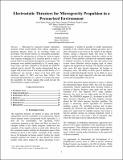| dc.contributor.author | Pina, Alexander L. | |
| dc.contributor.author | Wellman, Gregory | |
| dc.contributor.author | Garriott, Richard | |
| dc.contributor.author | Saenz Otero, Alvar | |
| dc.contributor.author | Lozano, Paulo C | |
| dc.date.accessioned | 2011-04-08T22:04:03Z | |
| dc.date.available | 2011-04-08T22:04:03Z | |
| dc.date.issued | 2010-03 | |
| dc.identifier.isbn | 978-1-4244-3887-7 | |
| dc.identifier.issn | 1095-323X | |
| dc.identifier.other | INSPEC Accession Number: 11258229 | |
| dc.identifier.uri | http://hdl.handle.net/1721.1/62186 | |
| dc.description.abstract | Motivated by long-term human exploration missions which could benefit from robotic assistants, a prototype thruster based on an Ion-Drag Pump was developed. This thruster utilizes no consumable propellant. Its operated by ionizing the air it floats in. Such an engine only requires recharging of its electrical power in order to propel itself in a pressurized microgravity environment. The prototypes were modeled analytically in 1D, tested using a micro-scale, and then validated in 3D aboard the ZERO-G reduced gravity aircraft. The results demonstrated that an engine with an inlet area of 5cm2 and a needle density of 1.0 needles/cm2 can provide a thrust of at least 3mN with electrical inputs of 10kV and less than 100uA. The successful demonstration is a proof of concept and opens the possibility for future engines that could provide the desired thrust to support astronauts. | en_US |
| dc.language.iso | en_US | |
| dc.publisher | Institute of Electrical and Electronics Engineers | en_US |
| dc.relation.isversionof | http://dx.doi.org/10.1109/AERO.2010.5446772 | en_US |
| dc.rights | Article is made available in accordance with the publisher's policy and may be subject to US copyright law. Please refer to the publisher's site for terms of use. | en_US |
| dc.source | IEEE | en_US |
| dc.title | Electrostatic Thrusters for Microgravity Propulsion in a Pressurized Environment | en_US |
| dc.type | Article | en_US |
| dc.identifier.citation | Saenz-Otero, A. et al. “Electrostatic Thrusters for Microgravity Propulsion in a Pressurized Environment.” Aerospace Conference, 2010 IEEE. 2010. 1-15. Copyright © 2010, IEEE | en_US |
| dc.contributor.department | Lincoln Laboratory | en_US |
| dc.contributor.department | Massachusetts Institute of Technology. Department of Aeronautics and Astronautics | en_US |
| dc.contributor.department | Massachusetts Institute of Technology. Space Systems Laboratory | en_US |
| dc.contributor.approver | Lozano, Paulo C. | |
| dc.contributor.mitauthor | Saenz-Otero, Alvar | |
| dc.contributor.mitauthor | Pina, Alexander L. | |
| dc.contributor.mitauthor | Wellman, Gregory | |
| dc.contributor.mitauthor | Lozano, Paulo C. | |
| dc.relation.journal | IEEE Aerospace Conference | en_US |
| dc.eprint.version | Final published version | en_US |
| dc.type.uri | http://purl.org/eprint/type/ConferencePaper | en_US |
| dspace.orderedauthors | Saenz-Otero, Alvar; Pina, Alex; Wellman, Gregory; Lozano, Paulo; Garriott, Richard | en |
| dc.identifier.orcid | https://orcid.org/0000-0002-6063-3227 | |
| mit.license | PUBLISHER_POLICY | en_US |
| mit.metadata.status | Complete | |
